University Finance: Manage Budget and Financial Plan Assignment
VerifiedAdded on 2023/04/23
|16
|2732
|439
Homework Assignment
AI Summary
This assignment delves into comprehensive financial planning and budget management. It explores essential topics such as estimating wage rates, utilizing banking records, and understanding the importance of contingency plans in organizations. The assignment covers financial planning, internal and external factors affecting financial plans, and the objectives of budgeting, including resource allocation, performance measurement, and cash flow prediction. It also includes variance analysis, cash management strategies, and cost-volume-profit (CVP) analysis to determine break-even points. The document also includes an overview of the accounting cycle, accounting rules, and the importance of stakeholder involvement in the budgeting process. The assignment explores data collection methods, including primary and secondary sources, and explains how data collection supports performance management. Finally, it covers GST legislation, labor rate variance analysis, and the evaluation of financial management information systems.
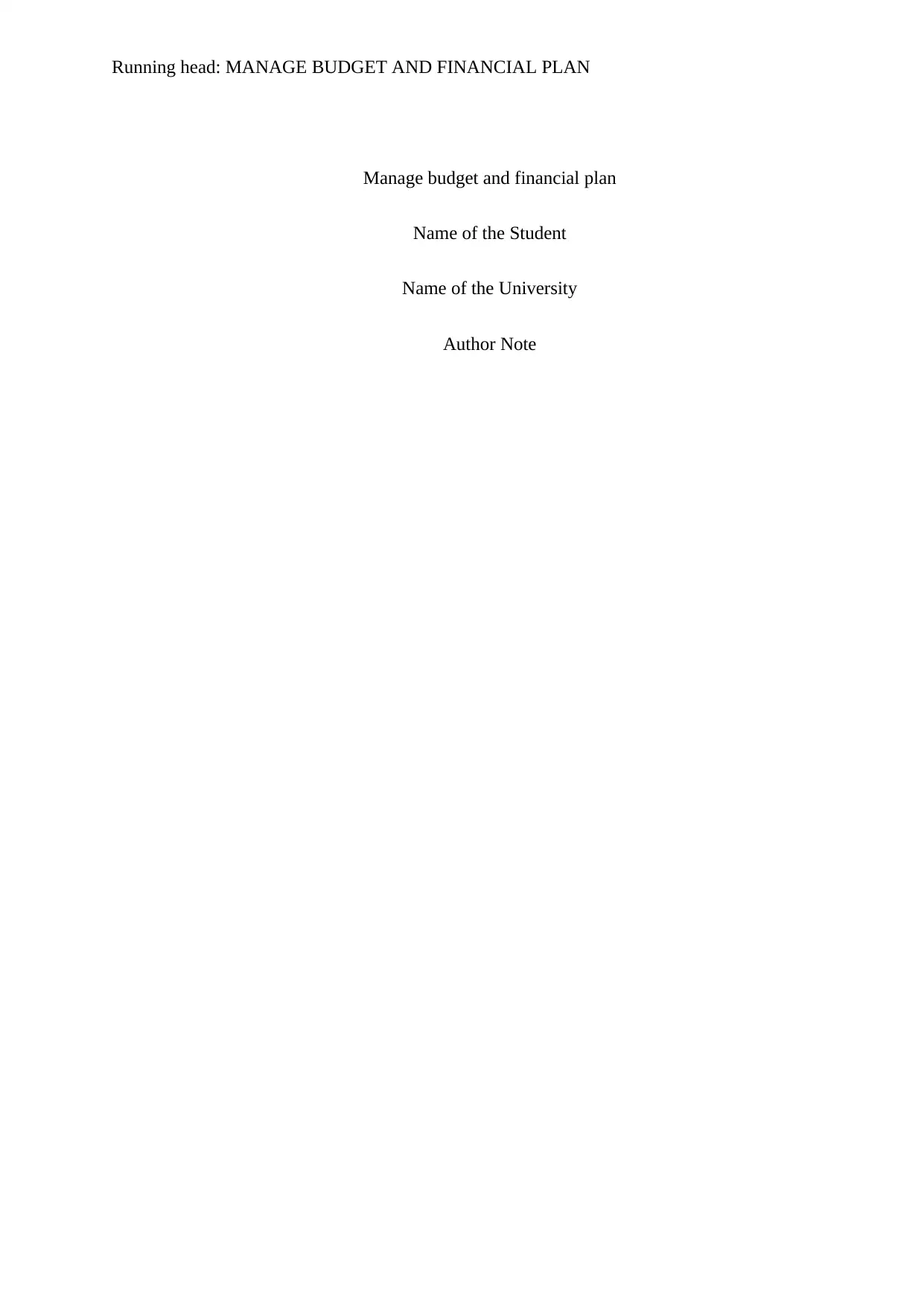
Running head: MANAGE BUDGET AND FINANCIAL PLAN
Manage budget and financial plan
Name of the Student
Name of the University
Author Note
Manage budget and financial plan
Name of the Student
Name of the University
Author Note
Paraphrase This Document
Need a fresh take? Get an instant paraphrase of this document with our AI Paraphraser
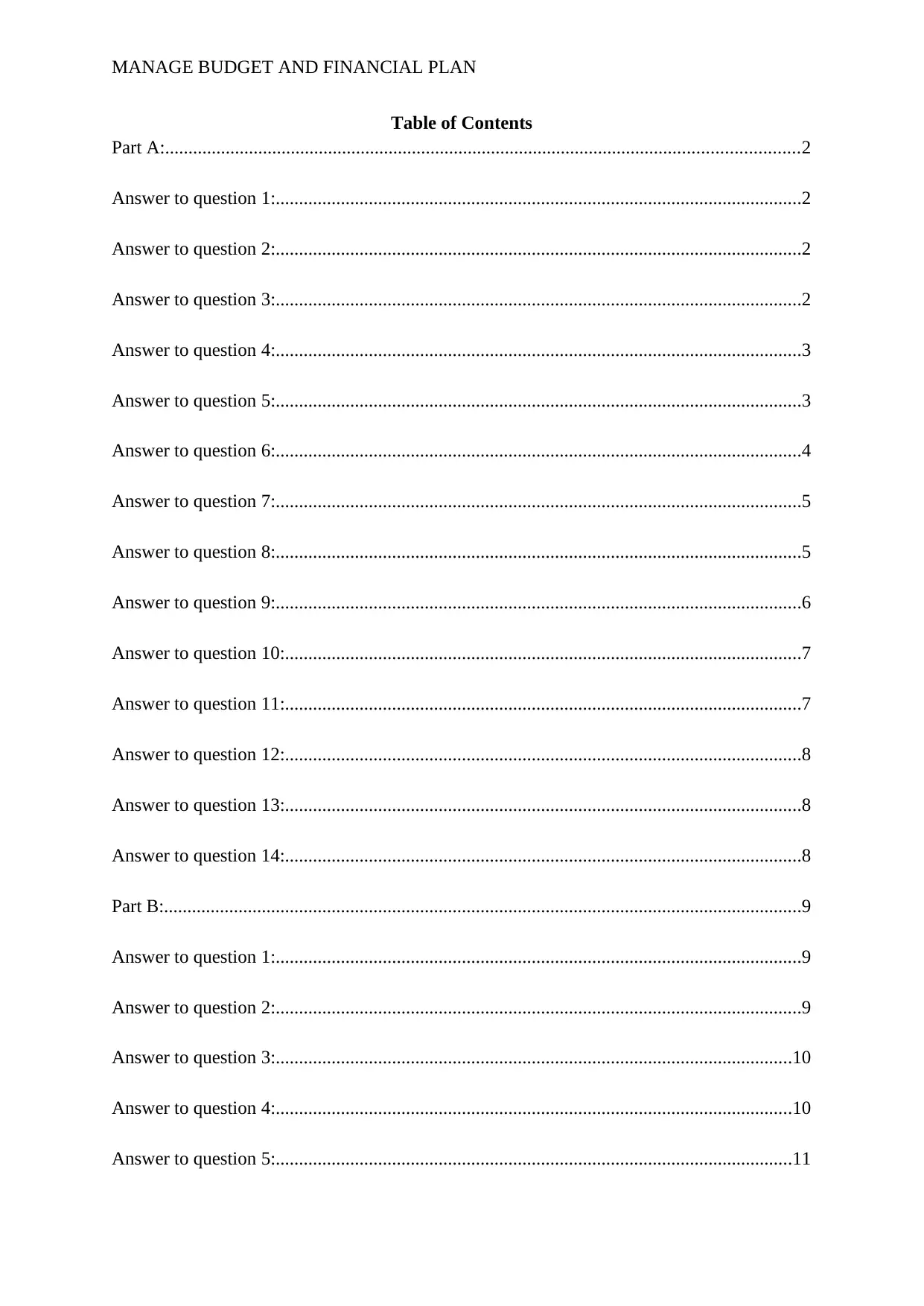
MANAGE BUDGET AND FINANCIAL PLAN
Table of Contents
Part A:........................................................................................................................................2
Answer to question 1:.................................................................................................................2
Answer to question 2:.................................................................................................................2
Answer to question 3:.................................................................................................................2
Answer to question 4:.................................................................................................................3
Answer to question 5:.................................................................................................................3
Answer to question 6:.................................................................................................................4
Answer to question 7:.................................................................................................................5
Answer to question 8:.................................................................................................................5
Answer to question 9:.................................................................................................................6
Answer to question 10:...............................................................................................................7
Answer to question 11:...............................................................................................................7
Answer to question 12:...............................................................................................................8
Answer to question 13:...............................................................................................................8
Answer to question 14:...............................................................................................................8
Part B:.........................................................................................................................................9
Answer to question 1:.................................................................................................................9
Answer to question 2:.................................................................................................................9
Answer to question 3:...............................................................................................................10
Answer to question 4:...............................................................................................................10
Answer to question 5:...............................................................................................................11
Table of Contents
Part A:........................................................................................................................................2
Answer to question 1:.................................................................................................................2
Answer to question 2:.................................................................................................................2
Answer to question 3:.................................................................................................................2
Answer to question 4:.................................................................................................................3
Answer to question 5:.................................................................................................................3
Answer to question 6:.................................................................................................................4
Answer to question 7:.................................................................................................................5
Answer to question 8:.................................................................................................................5
Answer to question 9:.................................................................................................................6
Answer to question 10:...............................................................................................................7
Answer to question 11:...............................................................................................................7
Answer to question 12:...............................................................................................................8
Answer to question 13:...............................................................................................................8
Answer to question 14:...............................................................................................................8
Part B:.........................................................................................................................................9
Answer to question 1:.................................................................................................................9
Answer to question 2:.................................................................................................................9
Answer to question 3:...............................................................................................................10
Answer to question 4:...............................................................................................................10
Answer to question 5:...............................................................................................................11
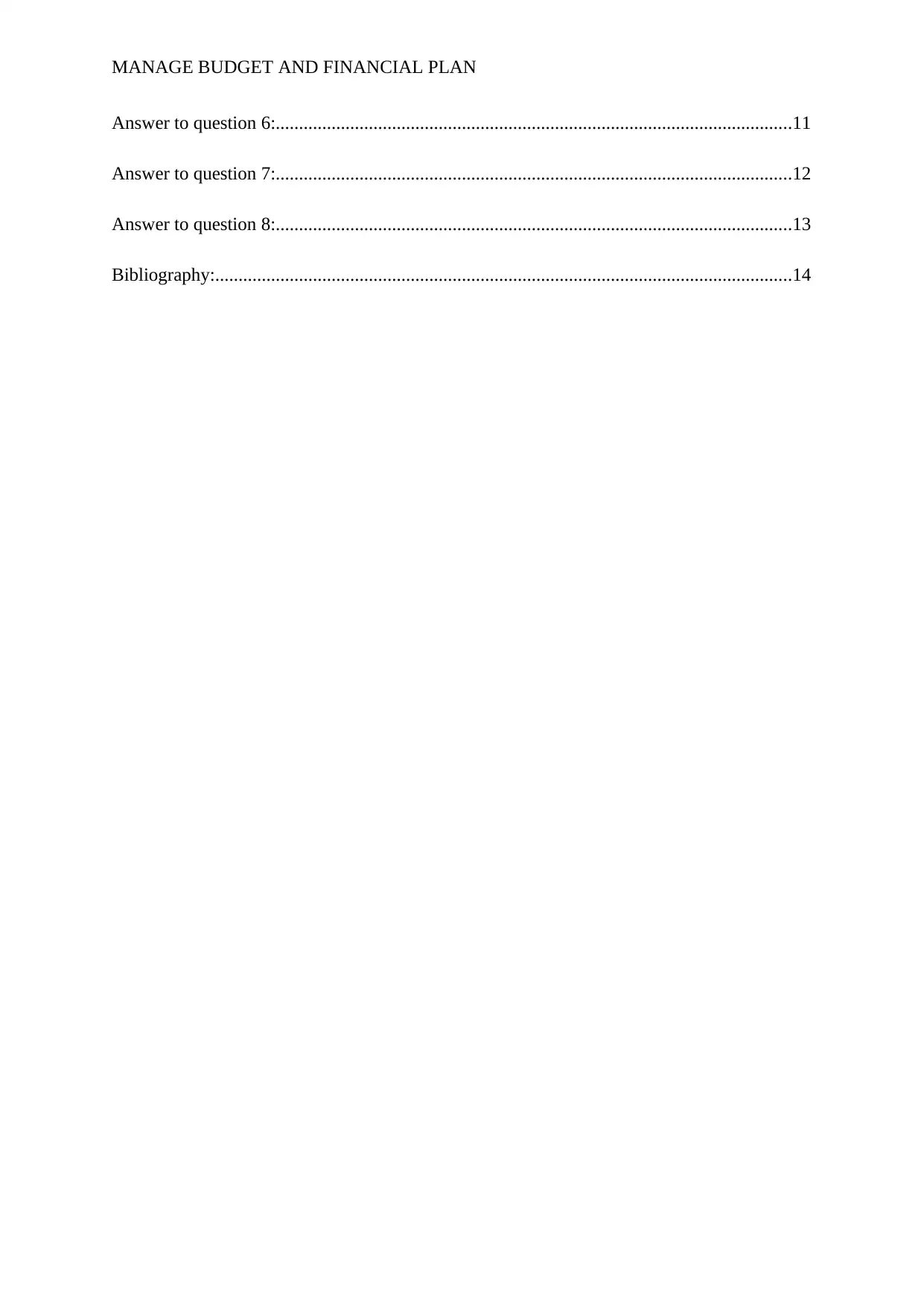
MANAGE BUDGET AND FINANCIAL PLAN
Answer to question 6:...............................................................................................................11
Answer to question 7:...............................................................................................................12
Answer to question 8:...............................................................................................................13
Bibliography:............................................................................................................................14
Answer to question 6:...............................................................................................................11
Answer to question 7:...............................................................................................................12
Answer to question 8:...............................................................................................................13
Bibliography:............................................................................................................................14
⊘ This is a preview!⊘
Do you want full access?
Subscribe today to unlock all pages.

Trusted by 1+ million students worldwide
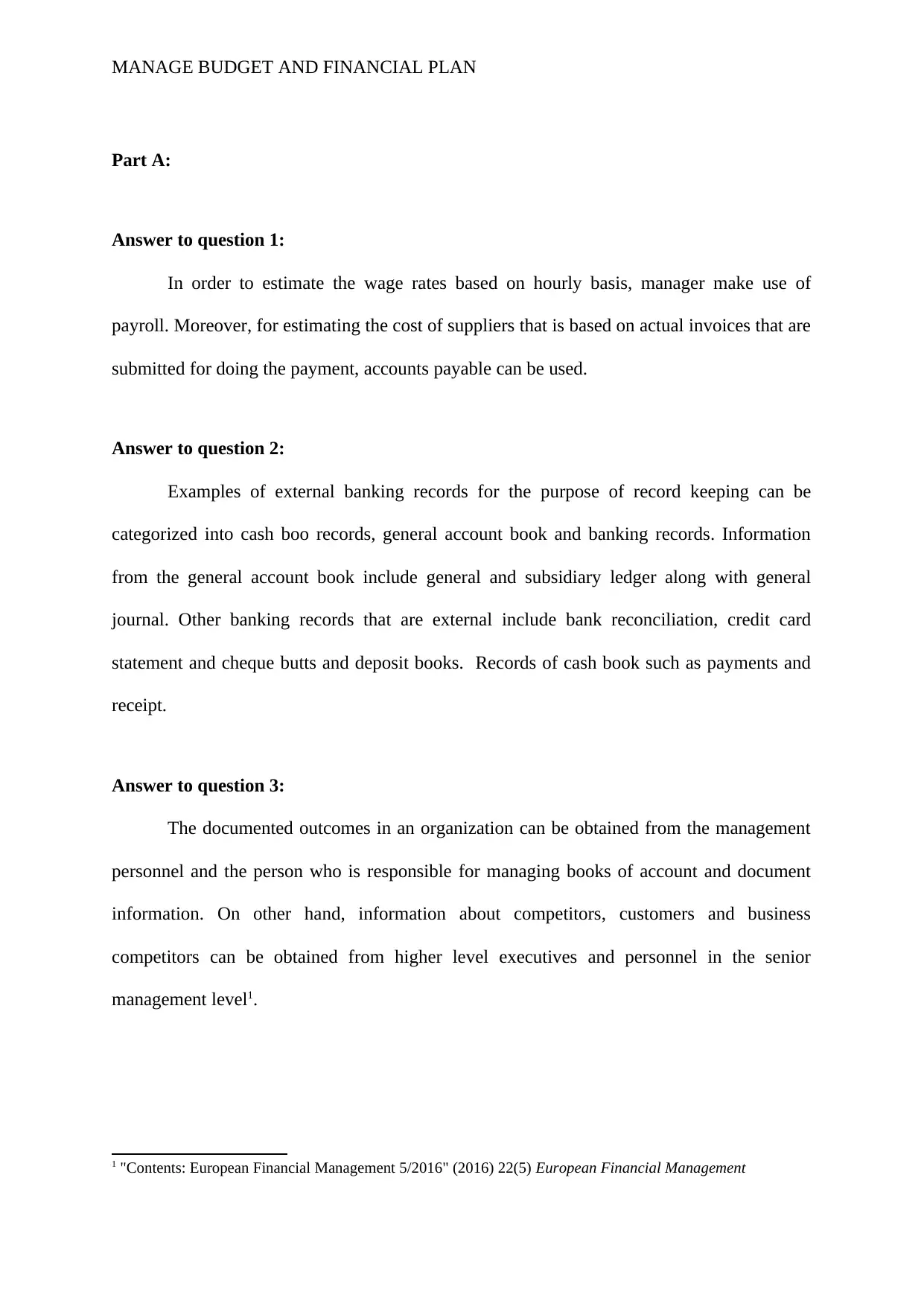
MANAGE BUDGET AND FINANCIAL PLAN
Part A:
Answer to question 1:
In order to estimate the wage rates based on hourly basis, manager make use of
payroll. Moreover, for estimating the cost of suppliers that is based on actual invoices that are
submitted for doing the payment, accounts payable can be used.
Answer to question 2:
Examples of external banking records for the purpose of record keeping can be
categorized into cash boo records, general account book and banking records. Information
from the general account book include general and subsidiary ledger along with general
journal. Other banking records that are external include bank reconciliation, credit card
statement and cheque butts and deposit books. Records of cash book such as payments and
receipt.
Answer to question 3:
The documented outcomes in an organization can be obtained from the management
personnel and the person who is responsible for managing books of account and document
information. On other hand, information about competitors, customers and business
competitors can be obtained from higher level executives and personnel in the senior
management level1.
1 "Contents: European Financial Management 5/2016" (2016) 22(5) European Financial Management
Part A:
Answer to question 1:
In order to estimate the wage rates based on hourly basis, manager make use of
payroll. Moreover, for estimating the cost of suppliers that is based on actual invoices that are
submitted for doing the payment, accounts payable can be used.
Answer to question 2:
Examples of external banking records for the purpose of record keeping can be
categorized into cash boo records, general account book and banking records. Information
from the general account book include general and subsidiary ledger along with general
journal. Other banking records that are external include bank reconciliation, credit card
statement and cheque butts and deposit books. Records of cash book such as payments and
receipt.
Answer to question 3:
The documented outcomes in an organization can be obtained from the management
personnel and the person who is responsible for managing books of account and document
information. On other hand, information about competitors, customers and business
competitors can be obtained from higher level executives and personnel in the senior
management level1.
1 "Contents: European Financial Management 5/2016" (2016) 22(5) European Financial Management
Paraphrase This Document
Need a fresh take? Get an instant paraphrase of this document with our AI Paraphraser
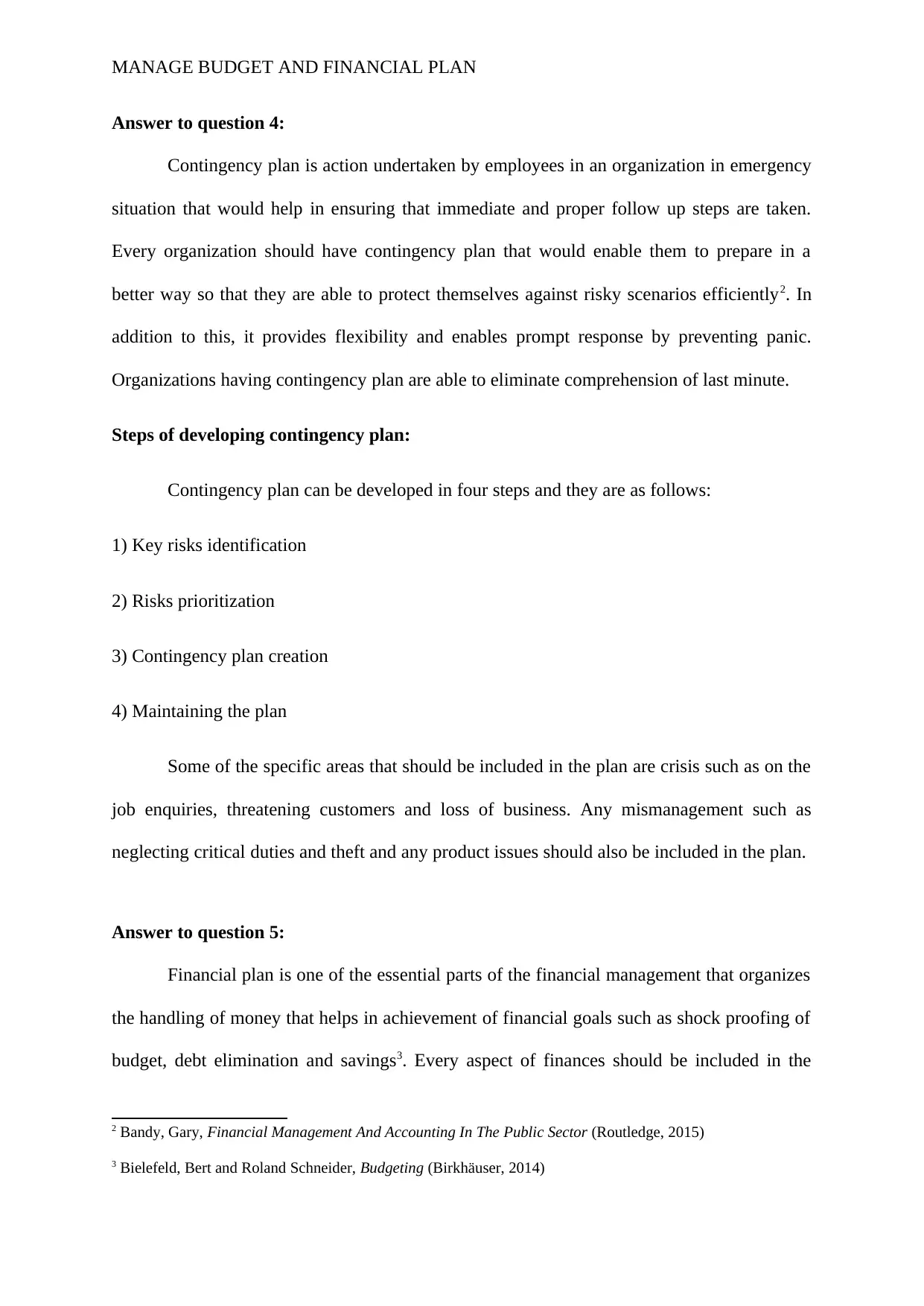
MANAGE BUDGET AND FINANCIAL PLAN
Answer to question 4:
Contingency plan is action undertaken by employees in an organization in emergency
situation that would help in ensuring that immediate and proper follow up steps are taken.
Every organization should have contingency plan that would enable them to prepare in a
better way so that they are able to protect themselves against risky scenarios efficiently2. In
addition to this, it provides flexibility and enables prompt response by preventing panic.
Organizations having contingency plan are able to eliminate comprehension of last minute.
Steps of developing contingency plan:
Contingency plan can be developed in four steps and they are as follows:
1) Key risks identification
2) Risks prioritization
3) Contingency plan creation
4) Maintaining the plan
Some of the specific areas that should be included in the plan are crisis such as on the
job enquiries, threatening customers and loss of business. Any mismanagement such as
neglecting critical duties and theft and any product issues should also be included in the plan.
Answer to question 5:
Financial plan is one of the essential parts of the financial management that organizes
the handling of money that helps in achievement of financial goals such as shock proofing of
budget, debt elimination and savings3. Every aspect of finances should be included in the
2 Bandy, Gary, Financial Management And Accounting In The Public Sector (Routledge, 2015)
3 Bielefeld, Bert and Roland Schneider, Budgeting (Birkhäuser, 2014)
Answer to question 4:
Contingency plan is action undertaken by employees in an organization in emergency
situation that would help in ensuring that immediate and proper follow up steps are taken.
Every organization should have contingency plan that would enable them to prepare in a
better way so that they are able to protect themselves against risky scenarios efficiently2. In
addition to this, it provides flexibility and enables prompt response by preventing panic.
Organizations having contingency plan are able to eliminate comprehension of last minute.
Steps of developing contingency plan:
Contingency plan can be developed in four steps and they are as follows:
1) Key risks identification
2) Risks prioritization
3) Contingency plan creation
4) Maintaining the plan
Some of the specific areas that should be included in the plan are crisis such as on the
job enquiries, threatening customers and loss of business. Any mismanagement such as
neglecting critical duties and theft and any product issues should also be included in the plan.
Answer to question 5:
Financial plan is one of the essential parts of the financial management that organizes
the handling of money that helps in achievement of financial goals such as shock proofing of
budget, debt elimination and savings3. Every aspect of finances should be included in the
2 Bandy, Gary, Financial Management And Accounting In The Public Sector (Routledge, 2015)
3 Bielefeld, Bert and Roland Schneider, Budgeting (Birkhäuser, 2014)
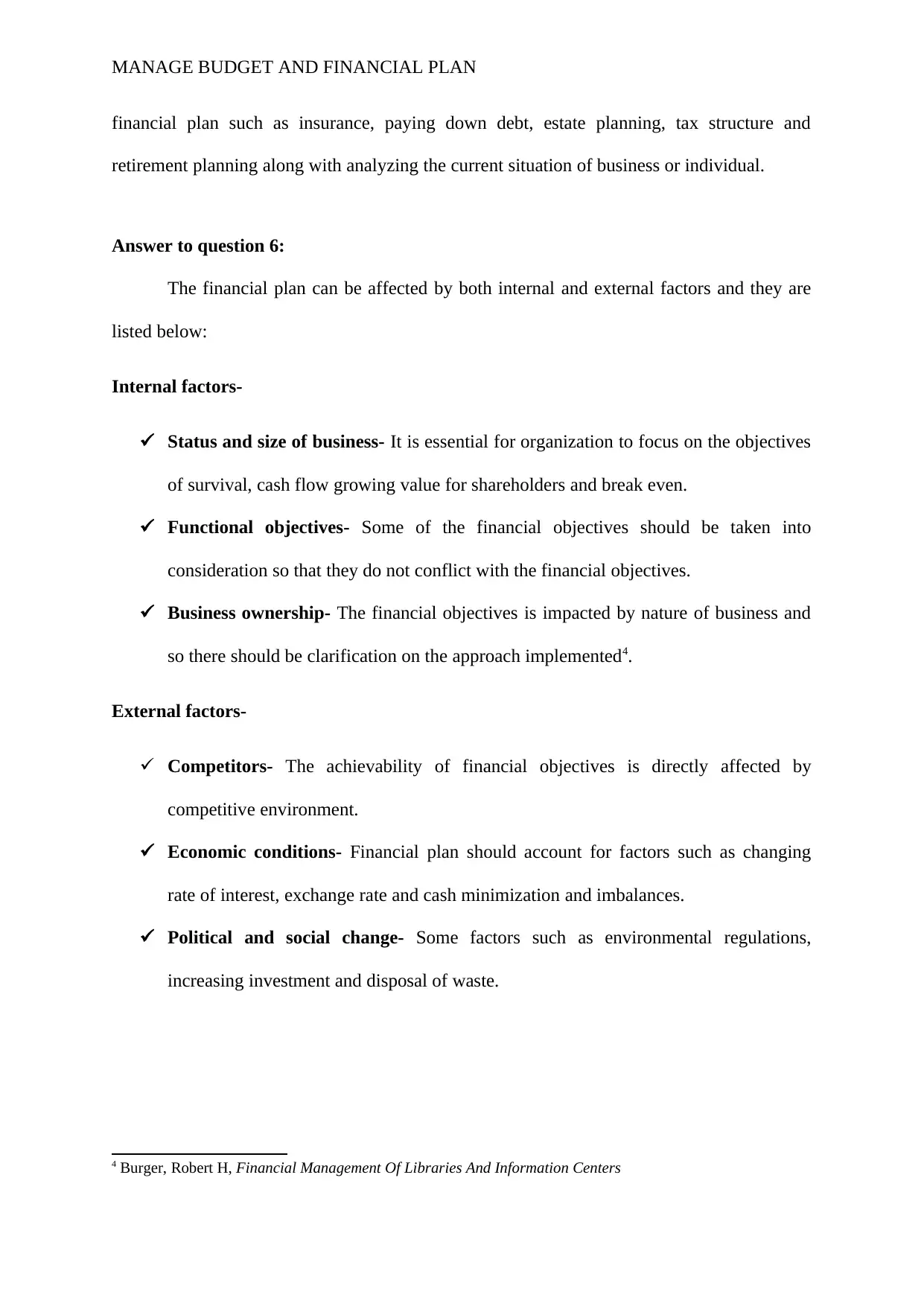
MANAGE BUDGET AND FINANCIAL PLAN
financial plan such as insurance, paying down debt, estate planning, tax structure and
retirement planning along with analyzing the current situation of business or individual.
Answer to question 6:
The financial plan can be affected by both internal and external factors and they are
listed below:
Internal factors-
Status and size of business- It is essential for organization to focus on the objectives
of survival, cash flow growing value for shareholders and break even.
Functional objectives- Some of the financial objectives should be taken into
consideration so that they do not conflict with the financial objectives.
Business ownership- The financial objectives is impacted by nature of business and
so there should be clarification on the approach implemented4.
External factors-
Competitors- The achievability of financial objectives is directly affected by
competitive environment.
Economic conditions- Financial plan should account for factors such as changing
rate of interest, exchange rate and cash minimization and imbalances.
Political and social change- Some factors such as environmental regulations,
increasing investment and disposal of waste.
4 Burger, Robert H, Financial Management Of Libraries And Information Centers
financial plan such as insurance, paying down debt, estate planning, tax structure and
retirement planning along with analyzing the current situation of business or individual.
Answer to question 6:
The financial plan can be affected by both internal and external factors and they are
listed below:
Internal factors-
Status and size of business- It is essential for organization to focus on the objectives
of survival, cash flow growing value for shareholders and break even.
Functional objectives- Some of the financial objectives should be taken into
consideration so that they do not conflict with the financial objectives.
Business ownership- The financial objectives is impacted by nature of business and
so there should be clarification on the approach implemented4.
External factors-
Competitors- The achievability of financial objectives is directly affected by
competitive environment.
Economic conditions- Financial plan should account for factors such as changing
rate of interest, exchange rate and cash minimization and imbalances.
Political and social change- Some factors such as environmental regulations,
increasing investment and disposal of waste.
4 Burger, Robert H, Financial Management Of Libraries And Information Centers
⊘ This is a preview!⊘
Do you want full access?
Subscribe today to unlock all pages.

Trusted by 1+ million students worldwide
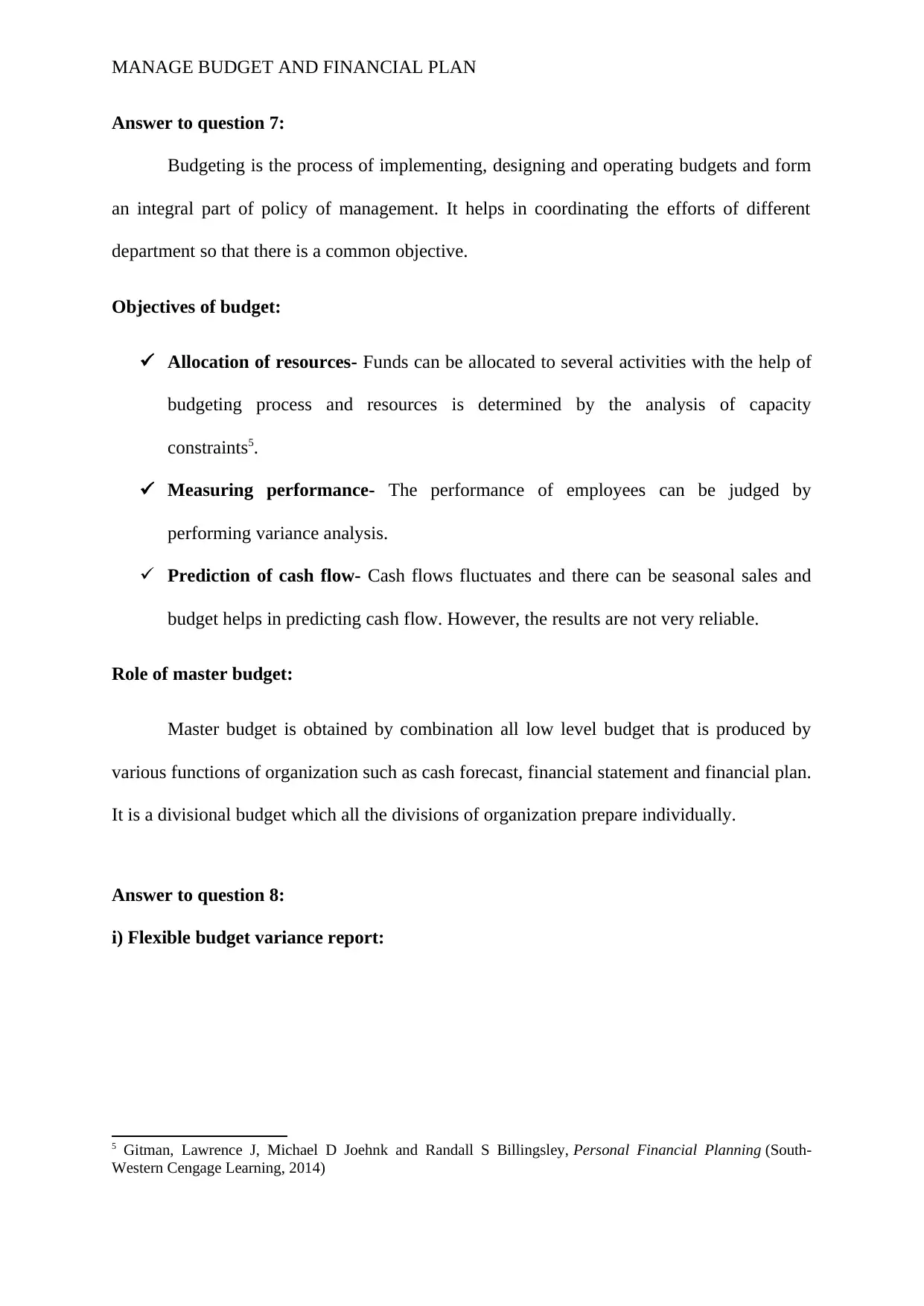
MANAGE BUDGET AND FINANCIAL PLAN
Answer to question 7:
Budgeting is the process of implementing, designing and operating budgets and form
an integral part of policy of management. It helps in coordinating the efforts of different
department so that there is a common objective.
Objectives of budget:
Allocation of resources- Funds can be allocated to several activities with the help of
budgeting process and resources is determined by the analysis of capacity
constraints5.
Measuring performance- The performance of employees can be judged by
performing variance analysis.
Prediction of cash flow- Cash flows fluctuates and there can be seasonal sales and
budget helps in predicting cash flow. However, the results are not very reliable.
Role of master budget:
Master budget is obtained by combination all low level budget that is produced by
various functions of organization such as cash forecast, financial statement and financial plan.
It is a divisional budget which all the divisions of organization prepare individually.
Answer to question 8:
i) Flexible budget variance report:
5 Gitman, Lawrence J, Michael D Joehnk and Randall S Billingsley, Personal Financial Planning (South-
Western Cengage Learning, 2014)
Answer to question 7:
Budgeting is the process of implementing, designing and operating budgets and form
an integral part of policy of management. It helps in coordinating the efforts of different
department so that there is a common objective.
Objectives of budget:
Allocation of resources- Funds can be allocated to several activities with the help of
budgeting process and resources is determined by the analysis of capacity
constraints5.
Measuring performance- The performance of employees can be judged by
performing variance analysis.
Prediction of cash flow- Cash flows fluctuates and there can be seasonal sales and
budget helps in predicting cash flow. However, the results are not very reliable.
Role of master budget:
Master budget is obtained by combination all low level budget that is produced by
various functions of organization such as cash forecast, financial statement and financial plan.
It is a divisional budget which all the divisions of organization prepare individually.
Answer to question 8:
i) Flexible budget variance report:
5 Gitman, Lawrence J, Michael D Joehnk and Randall S Billingsley, Personal Financial Planning (South-
Western Cengage Learning, 2014)
Paraphrase This Document
Need a fresh take? Get an instant paraphrase of this document with our AI Paraphraser
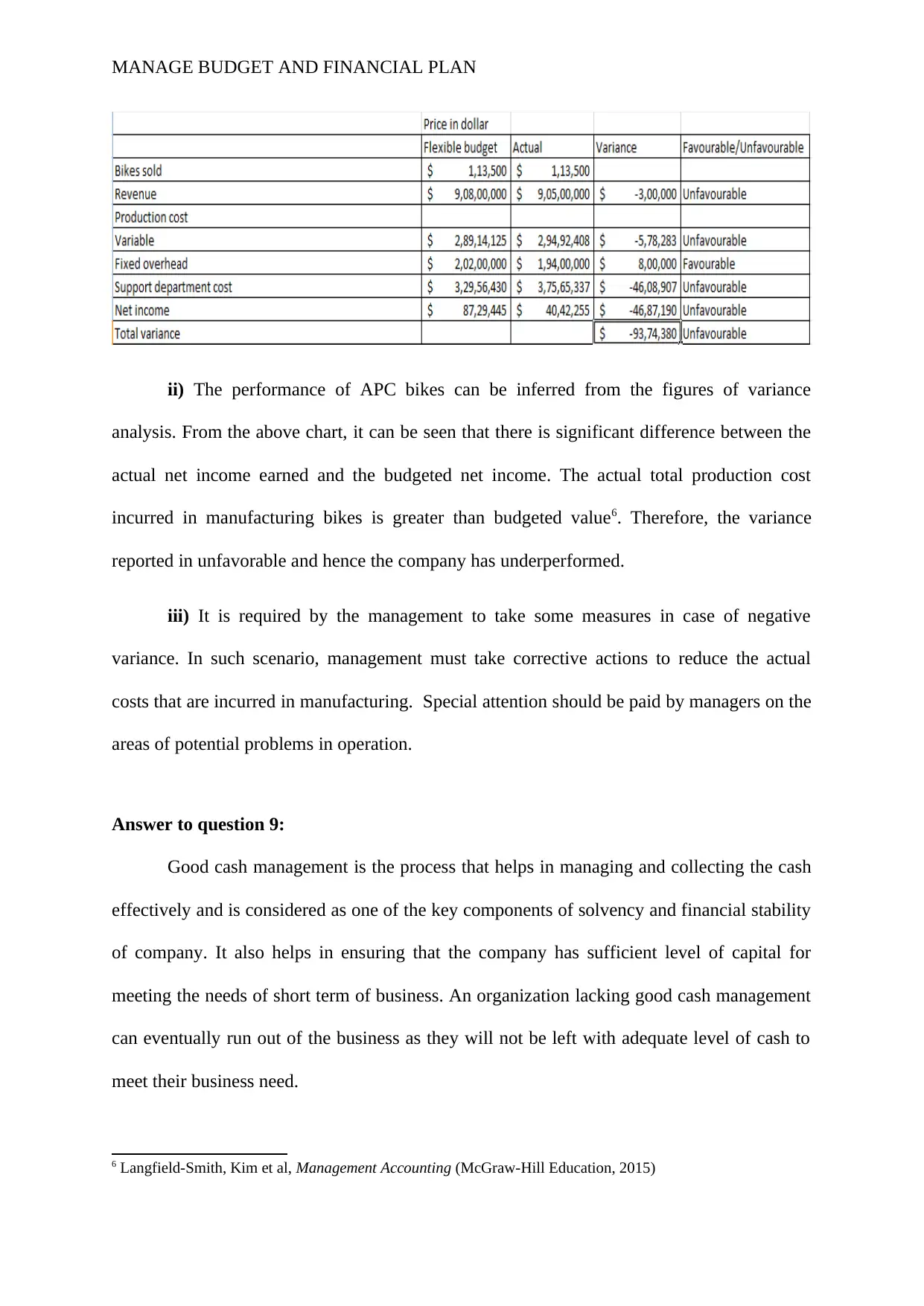
MANAGE BUDGET AND FINANCIAL PLAN
ii) The performance of APC bikes can be inferred from the figures of variance
analysis. From the above chart, it can be seen that there is significant difference between the
actual net income earned and the budgeted net income. The actual total production cost
incurred in manufacturing bikes is greater than budgeted value6. Therefore, the variance
reported in unfavorable and hence the company has underperformed.
iii) It is required by the management to take some measures in case of negative
variance. In such scenario, management must take corrective actions to reduce the actual
costs that are incurred in manufacturing. Special attention should be paid by managers on the
areas of potential problems in operation.
Answer to question 9:
Good cash management is the process that helps in managing and collecting the cash
effectively and is considered as one of the key components of solvency and financial stability
of company. It also helps in ensuring that the company has sufficient level of capital for
meeting the needs of short term of business. An organization lacking good cash management
can eventually run out of the business as they will not be left with adequate level of cash to
meet their business need.
6 Langfield-Smith, Kim et al, Management Accounting (McGraw-Hill Education, 2015)
ii) The performance of APC bikes can be inferred from the figures of variance
analysis. From the above chart, it can be seen that there is significant difference between the
actual net income earned and the budgeted net income. The actual total production cost
incurred in manufacturing bikes is greater than budgeted value6. Therefore, the variance
reported in unfavorable and hence the company has underperformed.
iii) It is required by the management to take some measures in case of negative
variance. In such scenario, management must take corrective actions to reduce the actual
costs that are incurred in manufacturing. Special attention should be paid by managers on the
areas of potential problems in operation.
Answer to question 9:
Good cash management is the process that helps in managing and collecting the cash
effectively and is considered as one of the key components of solvency and financial stability
of company. It also helps in ensuring that the company has sufficient level of capital for
meeting the needs of short term of business. An organization lacking good cash management
can eventually run out of the business as they will not be left with adequate level of cash to
meet their business need.
6 Langfield-Smith, Kim et al, Management Accounting (McGraw-Hill Education, 2015)
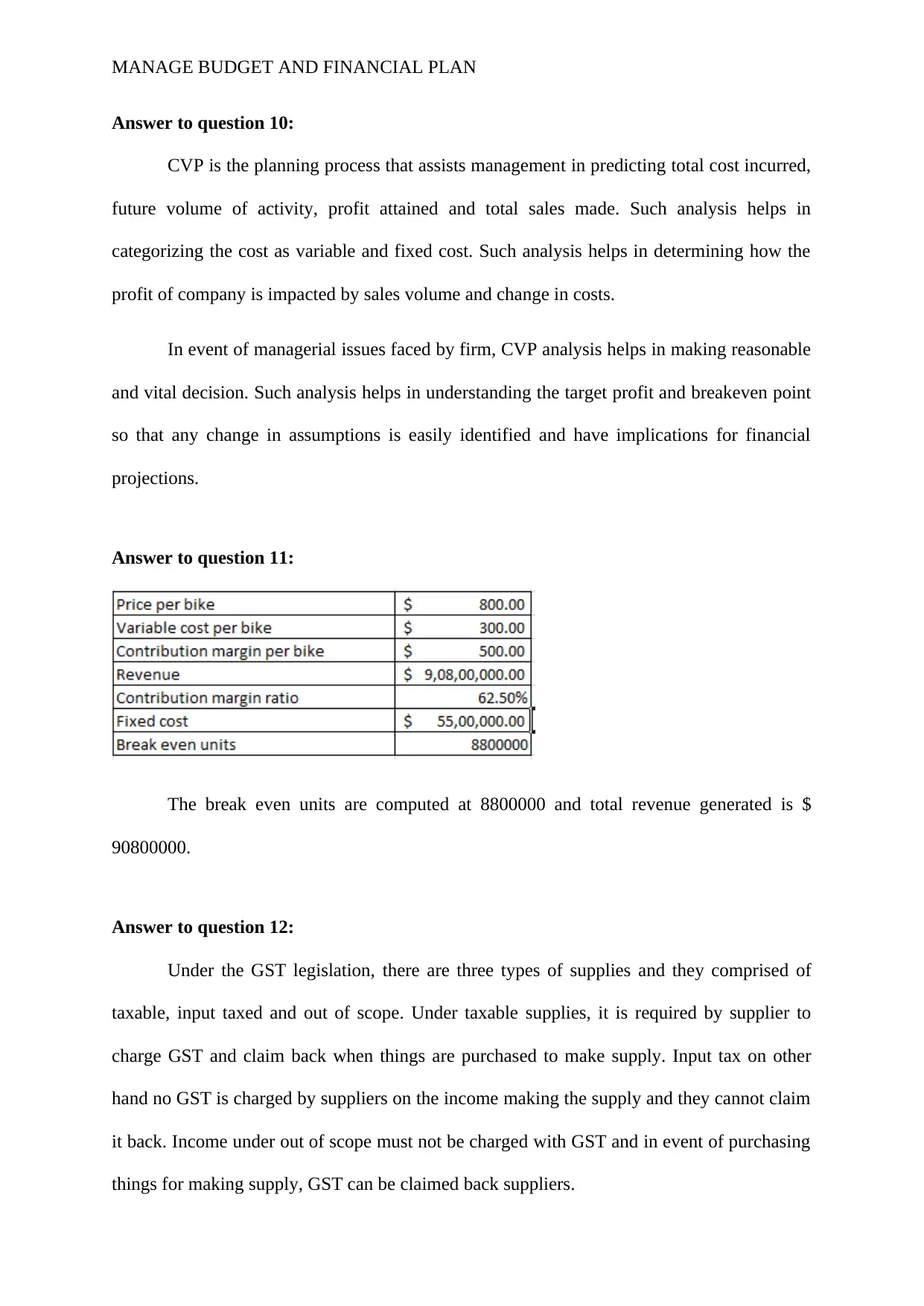
MANAGE BUDGET AND FINANCIAL PLAN
Answer to question 10:
CVP is the planning process that assists management in predicting total cost incurred,
future volume of activity, profit attained and total sales made. Such analysis helps in
categorizing the cost as variable and fixed cost. Such analysis helps in determining how the
profit of company is impacted by sales volume and change in costs.
In event of managerial issues faced by firm, CVP analysis helps in making reasonable
and vital decision. Such analysis helps in understanding the target profit and breakeven point
so that any change in assumptions is easily identified and have implications for financial
projections.
Answer to question 11:
The break even units are computed at 8800000 and total revenue generated is $
90800000.
Answer to question 12:
Under the GST legislation, there are three types of supplies and they comprised of
taxable, input taxed and out of scope. Under taxable supplies, it is required by supplier to
charge GST and claim back when things are purchased to make supply. Input tax on other
hand no GST is charged by suppliers on the income making the supply and they cannot claim
it back. Income under out of scope must not be charged with GST and in event of purchasing
things for making supply, GST can be claimed back suppliers.
Answer to question 10:
CVP is the planning process that assists management in predicting total cost incurred,
future volume of activity, profit attained and total sales made. Such analysis helps in
categorizing the cost as variable and fixed cost. Such analysis helps in determining how the
profit of company is impacted by sales volume and change in costs.
In event of managerial issues faced by firm, CVP analysis helps in making reasonable
and vital decision. Such analysis helps in understanding the target profit and breakeven point
so that any change in assumptions is easily identified and have implications for financial
projections.
Answer to question 11:
The break even units are computed at 8800000 and total revenue generated is $
90800000.
Answer to question 12:
Under the GST legislation, there are three types of supplies and they comprised of
taxable, input taxed and out of scope. Under taxable supplies, it is required by supplier to
charge GST and claim back when things are purchased to make supply. Input tax on other
hand no GST is charged by suppliers on the income making the supply and they cannot claim
it back. Income under out of scope must not be charged with GST and in event of purchasing
things for making supply, GST can be claimed back suppliers.
⊘ This is a preview!⊘
Do you want full access?
Subscribe today to unlock all pages.

Trusted by 1+ million students worldwide
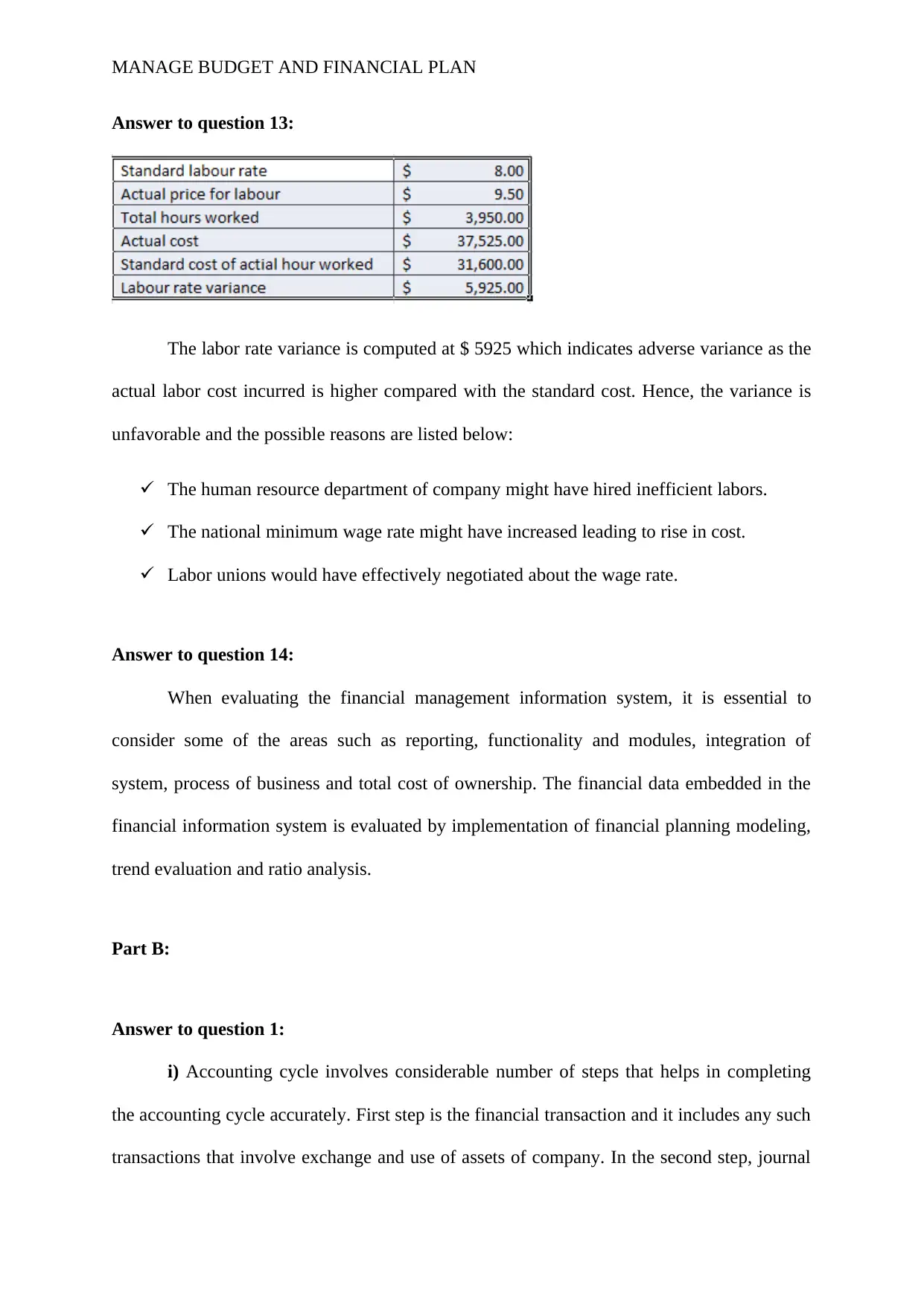
MANAGE BUDGET AND FINANCIAL PLAN
Answer to question 13:
The labor rate variance is computed at $ 5925 which indicates adverse variance as the
actual labor cost incurred is higher compared with the standard cost. Hence, the variance is
unfavorable and the possible reasons are listed below:
The human resource department of company might have hired inefficient labors.
The national minimum wage rate might have increased leading to rise in cost.
Labor unions would have effectively negotiated about the wage rate.
Answer to question 14:
When evaluating the financial management information system, it is essential to
consider some of the areas such as reporting, functionality and modules, integration of
system, process of business and total cost of ownership. The financial data embedded in the
financial information system is evaluated by implementation of financial planning modeling,
trend evaluation and ratio analysis.
Part B:
Answer to question 1:
i) Accounting cycle involves considerable number of steps that helps in completing
the accounting cycle accurately. First step is the financial transaction and it includes any such
transactions that involve exchange and use of assets of company. In the second step, journal
Answer to question 13:
The labor rate variance is computed at $ 5925 which indicates adverse variance as the
actual labor cost incurred is higher compared with the standard cost. Hence, the variance is
unfavorable and the possible reasons are listed below:
The human resource department of company might have hired inefficient labors.
The national minimum wage rate might have increased leading to rise in cost.
Labor unions would have effectively negotiated about the wage rate.
Answer to question 14:
When evaluating the financial management information system, it is essential to
consider some of the areas such as reporting, functionality and modules, integration of
system, process of business and total cost of ownership. The financial data embedded in the
financial information system is evaluated by implementation of financial planning modeling,
trend evaluation and ratio analysis.
Part B:
Answer to question 1:
i) Accounting cycle involves considerable number of steps that helps in completing
the accounting cycle accurately. First step is the financial transaction and it includes any such
transactions that involve exchange and use of assets of company. In the second step, journal
Paraphrase This Document
Need a fresh take? Get an instant paraphrase of this document with our AI Paraphraser
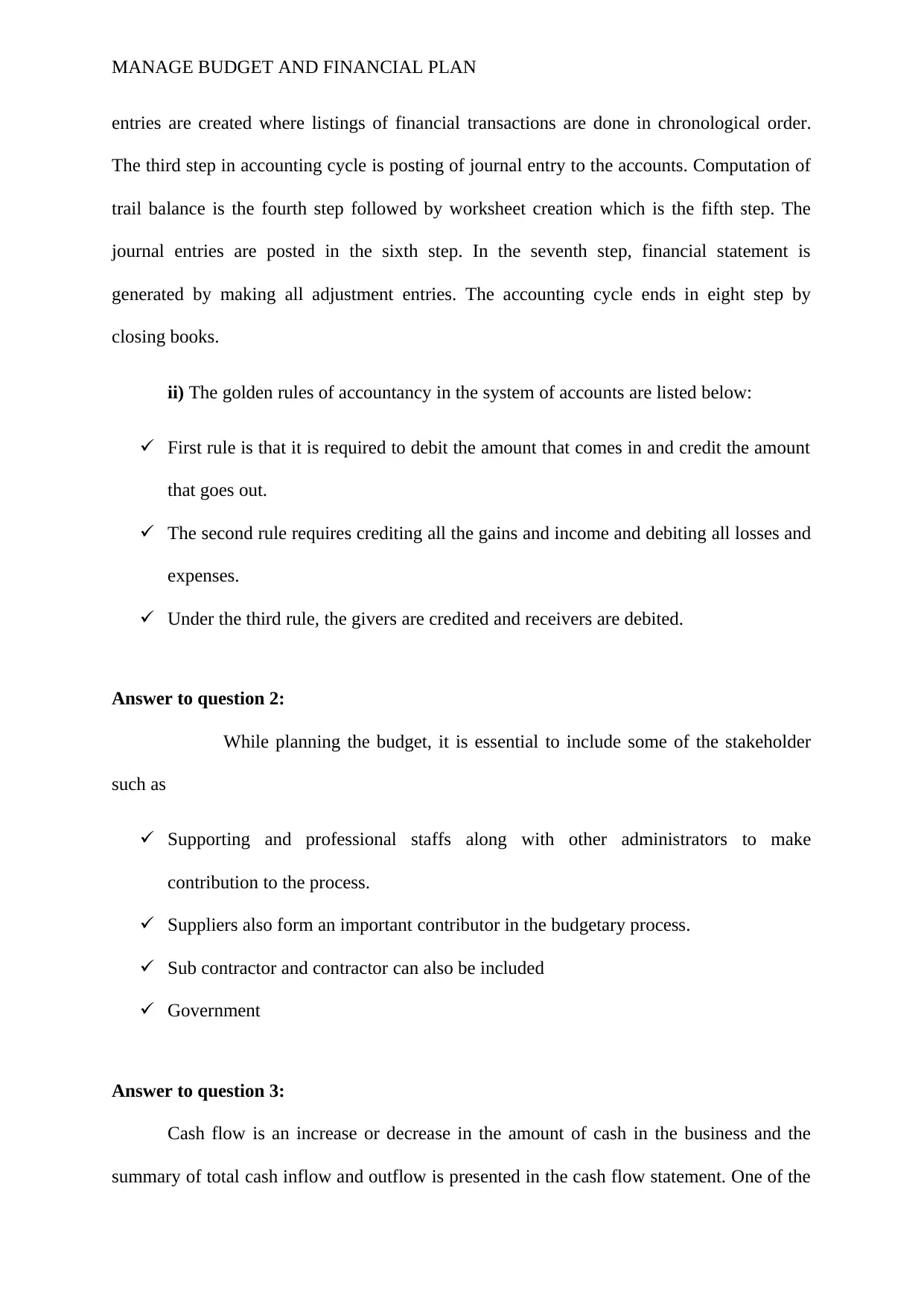
MANAGE BUDGET AND FINANCIAL PLAN
entries are created where listings of financial transactions are done in chronological order.
The third step in accounting cycle is posting of journal entry to the accounts. Computation of
trail balance is the fourth step followed by worksheet creation which is the fifth step. The
journal entries are posted in the sixth step. In the seventh step, financial statement is
generated by making all adjustment entries. The accounting cycle ends in eight step by
closing books.
ii) The golden rules of accountancy in the system of accounts are listed below:
First rule is that it is required to debit the amount that comes in and credit the amount
that goes out.
The second rule requires crediting all the gains and income and debiting all losses and
expenses.
Under the third rule, the givers are credited and receivers are debited.
Answer to question 2:
While planning the budget, it is essential to include some of the stakeholder
such as
Supporting and professional staffs along with other administrators to make
contribution to the process.
Suppliers also form an important contributor in the budgetary process.
Sub contractor and contractor can also be included
Government
Answer to question 3:
Cash flow is an increase or decrease in the amount of cash in the business and the
summary of total cash inflow and outflow is presented in the cash flow statement. One of the
entries are created where listings of financial transactions are done in chronological order.
The third step in accounting cycle is posting of journal entry to the accounts. Computation of
trail balance is the fourth step followed by worksheet creation which is the fifth step. The
journal entries are posted in the sixth step. In the seventh step, financial statement is
generated by making all adjustment entries. The accounting cycle ends in eight step by
closing books.
ii) The golden rules of accountancy in the system of accounts are listed below:
First rule is that it is required to debit the amount that comes in and credit the amount
that goes out.
The second rule requires crediting all the gains and income and debiting all losses and
expenses.
Under the third rule, the givers are credited and receivers are debited.
Answer to question 2:
While planning the budget, it is essential to include some of the stakeholder
such as
Supporting and professional staffs along with other administrators to make
contribution to the process.
Suppliers also form an important contributor in the budgetary process.
Sub contractor and contractor can also be included
Government
Answer to question 3:
Cash flow is an increase or decrease in the amount of cash in the business and the
summary of total cash inflow and outflow is presented in the cash flow statement. One of the
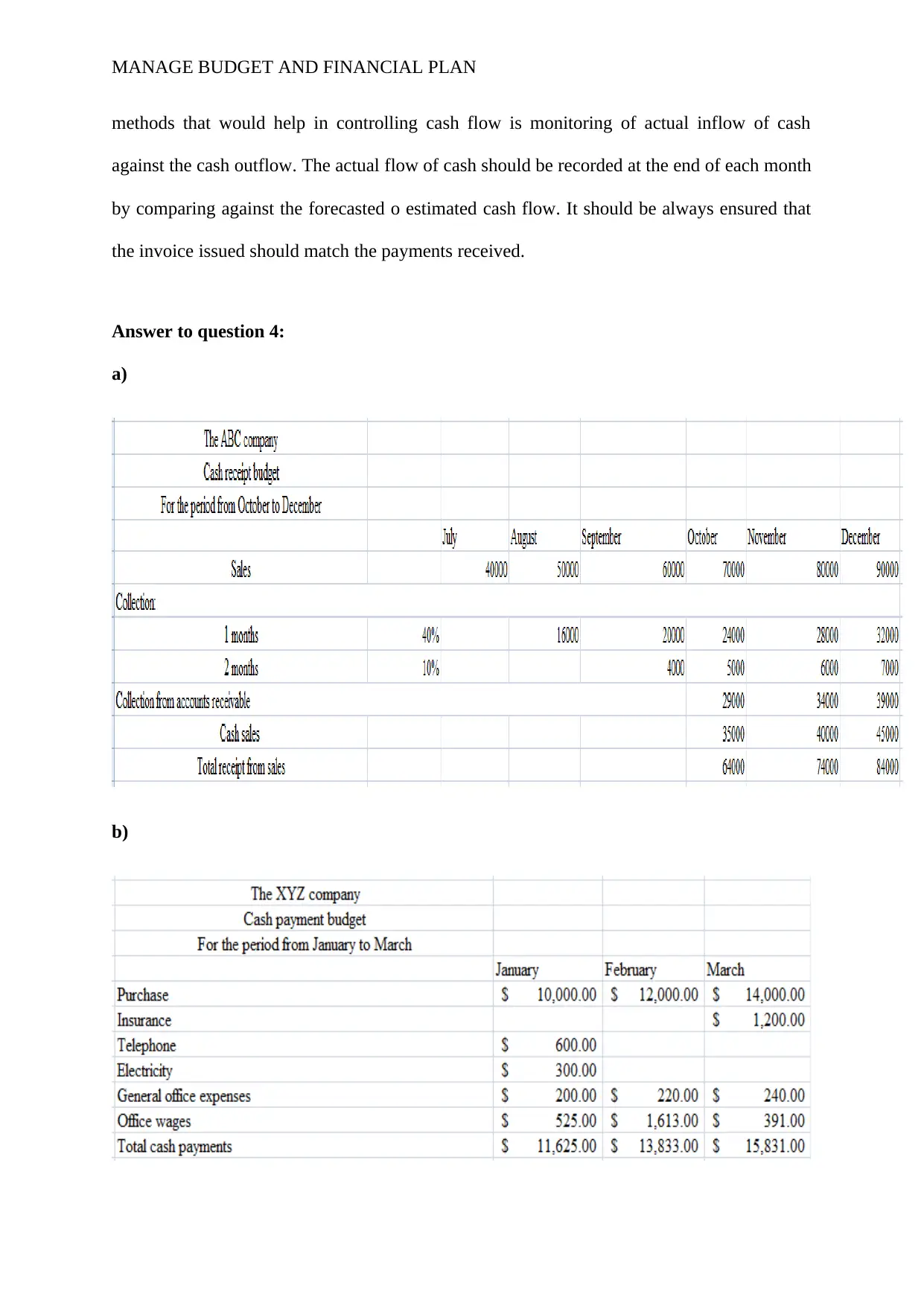
MANAGE BUDGET AND FINANCIAL PLAN
methods that would help in controlling cash flow is monitoring of actual inflow of cash
against the cash outflow. The actual flow of cash should be recorded at the end of each month
by comparing against the forecasted o estimated cash flow. It should be always ensured that
the invoice issued should match the payments received.
Answer to question 4:
a)
b)
methods that would help in controlling cash flow is monitoring of actual inflow of cash
against the cash outflow. The actual flow of cash should be recorded at the end of each month
by comparing against the forecasted o estimated cash flow. It should be always ensured that
the invoice issued should match the payments received.
Answer to question 4:
a)
b)
⊘ This is a preview!⊘
Do you want full access?
Subscribe today to unlock all pages.

Trusted by 1+ million students worldwide
1 out of 16
Related Documents
Your All-in-One AI-Powered Toolkit for Academic Success.
+13062052269
info@desklib.com
Available 24*7 on WhatsApp / Email
![[object Object]](/_next/static/media/star-bottom.7253800d.svg)
Unlock your academic potential
Copyright © 2020–2025 A2Z Services. All Rights Reserved. Developed and managed by ZUCOL.





